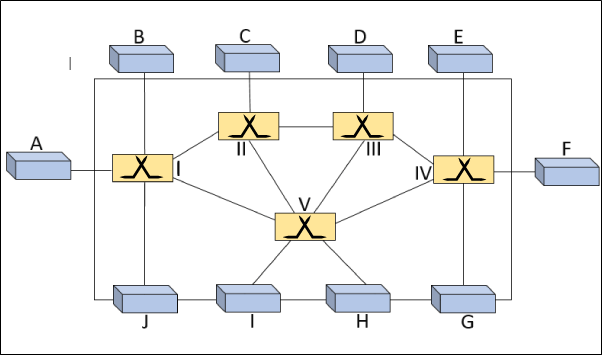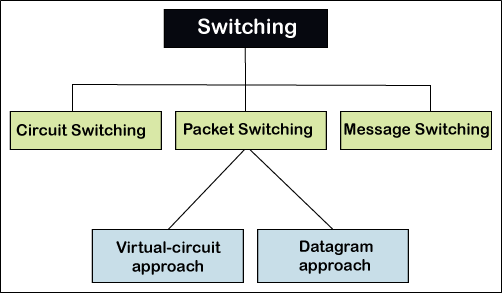Computer Network Switching
Switching
Many numbers of connected devices are called the network. Whenever a company has multiple devices, there has a problem of how to connected them to make the one to one communication possible. A better solution to these problems is switching. The chain of an interlink node is called a switched network. Switches are those devices to provide a temporary connection between two or more than two devices linked to the switches.

Advantages of Switching
- Switching increases the bandwidth of the network.
- It reduces the workload on a single computer.
- It increases network performance by reducing the traffic on the network.
Disadvantages of Switching
- It's very costly than bridges.
- It is very difficult to detect connectivity issues in it.
There are three methods of switching
Normally, there are three methods of switching: circuit switching, packet switching, and message switching. Circuit switching and Packet switching are both commonly used today days. Packet switching can be divided into two types virtual-circuit network and the datagram network. The message switching has been phased out in normal communication but not usable for networking. Sub-categories of Switching are shown in the below diagram.

Circuit switching
In the circuit switching networking, the physical nodes are connected to a set of switches. Circuit switching provides a dedicated route made up of one or more links in which each link is split into n channels. Usually, each link is split into n channels using by FDM or TDM. It is also called as the connection-oriented switching.
Some essential points in circuit switching:
- Circuit switching occurs work at the physical layer.
- The data transferred between the sender and receiver are not packed. The data are constantly flow sent by the source node and received by the destination node.
The telephone lines are the best example of circuit switching. The communication in circuit switching needed to three phases: connection established, data transfer, and connection teardown. Firstly, it established the connection between the sender and the receiver. Then it can be transferred to the data for both sides. After complete the data transfer, the connection is disconnected.
Packet Switching
In packet switching, the data is divided into smaller parts. These small parts are known as packets. There are all each package has its own source address and destination address. Each packet is further transmitted to the network based on these addresses. When all the packets reach their own destination address, they are all converted back to the original message. In packet switching, the network accepts the packets based on FCFS (first come first serve), i.e., the packet that first arrives is served first. Packet switching is used as an alternative to circuit switching. Packet switching can be divided into two types:
- Virtual-Circuit Network
- Datagram Network
Virtual-Circuit Network
In virtual-circuit network switching, one route is selected between the sender and receiver. All the packets are transmitted through this one route. Due to being transmitted through a route in virtual-circuit network switching, all packets reach the destination in systematic and correctly. It is called as the connection-oriented switching. The virtual-circuit network switching is usually done at the data link layer.
Datagram Network
In datagram networks, each packet is transmitted independently in the network, i.e., one packet has no connection with another packet. Packets in this switching network are called as the datagrams. These packets have a destination address from which they are transmitted in the network. Due to the packets being independent in datagram packet switching, they are transmitted through different routes. Which causes the packet to reach the destination poorly. The datagram network switching is usually done at the network layer. It is also called as connectionless switching.
Difference between Virtual Circuit network and Datagram network?
| Virtual Circuit network | Datagram network |
| It is also called as connection-oriented switching. | It is also called as connectionless switching. |
| Virtual circuit networks are highly reliable than the datagram network. | Datagram networks are not reliable than the virtual circuit network. |
| The implementation of virtual circuits is expensive because a new connection has to be established each time. | The implementation of datagram networks is cost-efficient because it is not required a new connection to established each time. |
| In the virtual circuit network, there is used a fixed path for sending the packets. | In the datagram network, there is not used a fixed path for sending the packets. |
| In the virtual circuit network, packets reach the destination in sequence because the packets follow the same path. | In the datagram network, packets reach the destination in random order because the packets do not follow the same path. |
Advantages of Packet switching
- It can send high data easily.
- It is very secure than other switching methods.
Disadvantages of Packet switching
- If the heavy data is transmitted in the network, then it takes a lot of time.
- There are many possibilities of corrupting data in this switching.
Message Switching
In message switching, when a message is sent, it is accompanied by its destination address. It is not required to establish any special route between the sender and receiver. In this, the message is transmitted from one node to another. When the node receives the complete message, it stores the message, and when the other node is ready to receive the message, it forwards the message. For this reason, it’s also called as store-forward switching. For this reason, its also called as store-forward switching.
Advantages of Message switching
- Message switching is efficient for data traffic management.
- Message switching reduces network blockages.
Disadvantages of Message switching
- It increases the cost due to its intermediate storage.
- It isn't suitable for devices in real-time such as data communication.
Difference between Circuit Switching and Packet Switching?
| Circuit switching | Packet switching |
| Circuit switching is a connection-oriented switching technique. | The packet switching technique is a connection-less switching technique. |
| Circuit switching was initially designed for voice communication between one device to another device. | Packet switching was initially designed for data transmission between one device to another device. |
| It is done at the physical layer. | It is done at the network layer. |
| It is not supported to the store and forward transmission. | It supports the store and forward transmission. |
| In the circuit switching technique, bandwidth wastage is more. | In the packet switching technique, bandwidth wastage is very low. |
Difference between Circuit switching and Message switching?
| Circuit switching | Message switching |
| Circuit switching is a connection-oriented switching technique. | The message switching technique is a connection-less switching technique. |
| It is geographical addressing in the circuit switching. | It is hierarchical addressing in the message switching. |
| It is more expensive than message switching. | It is less expensive than circuit switching. |
| It does not store the information. | It stores the information firstly, then forwards it to the next device. |